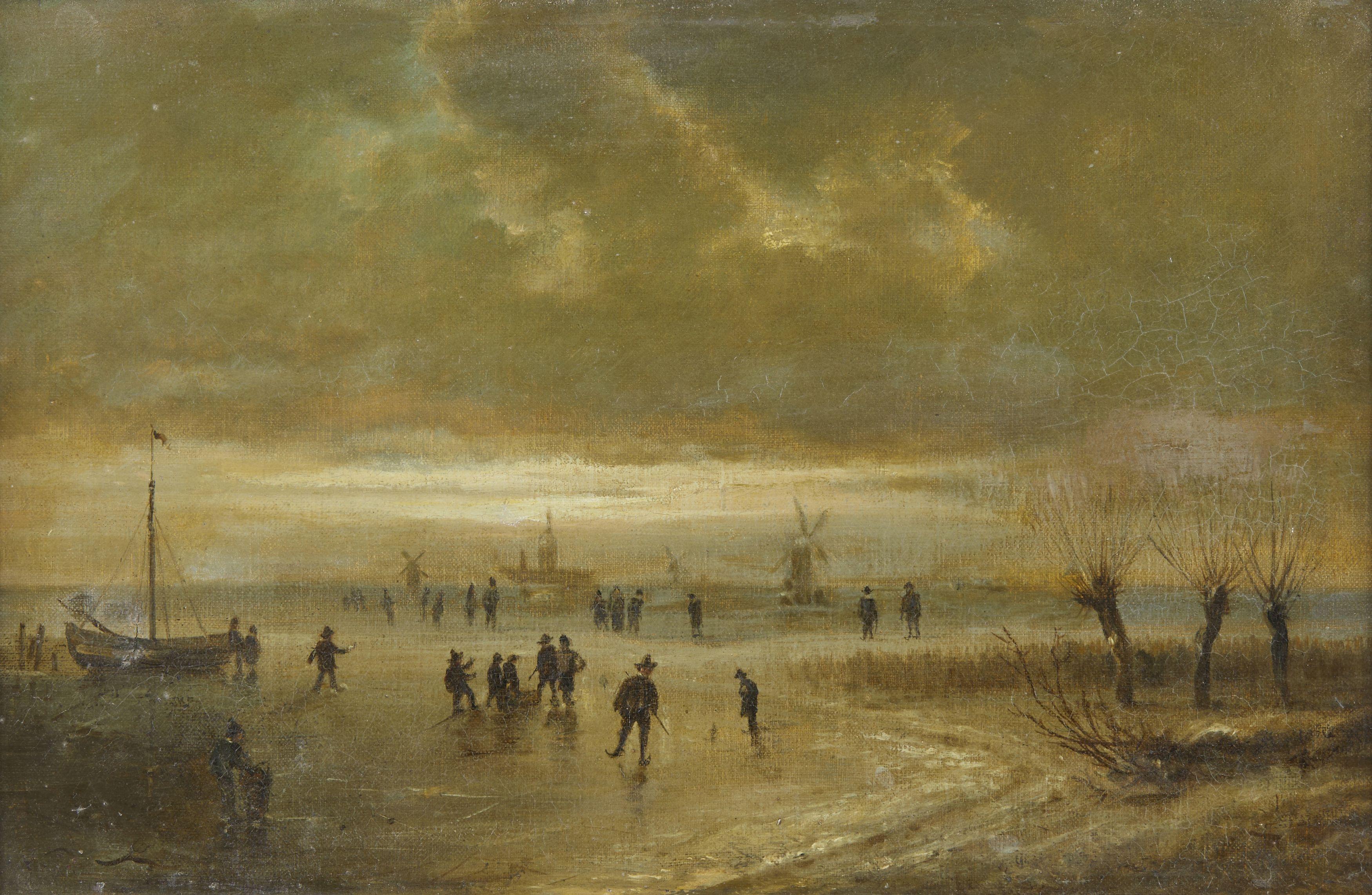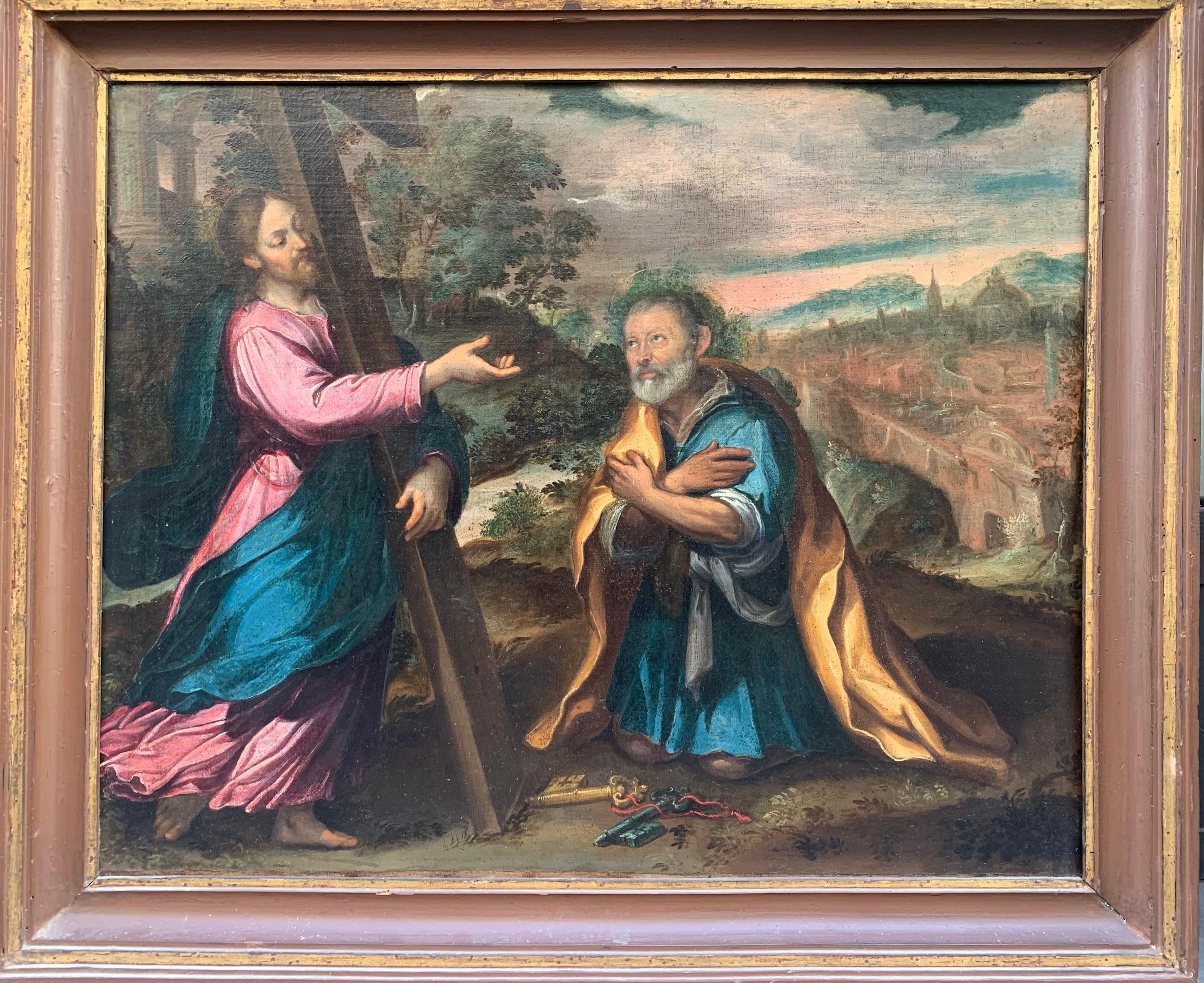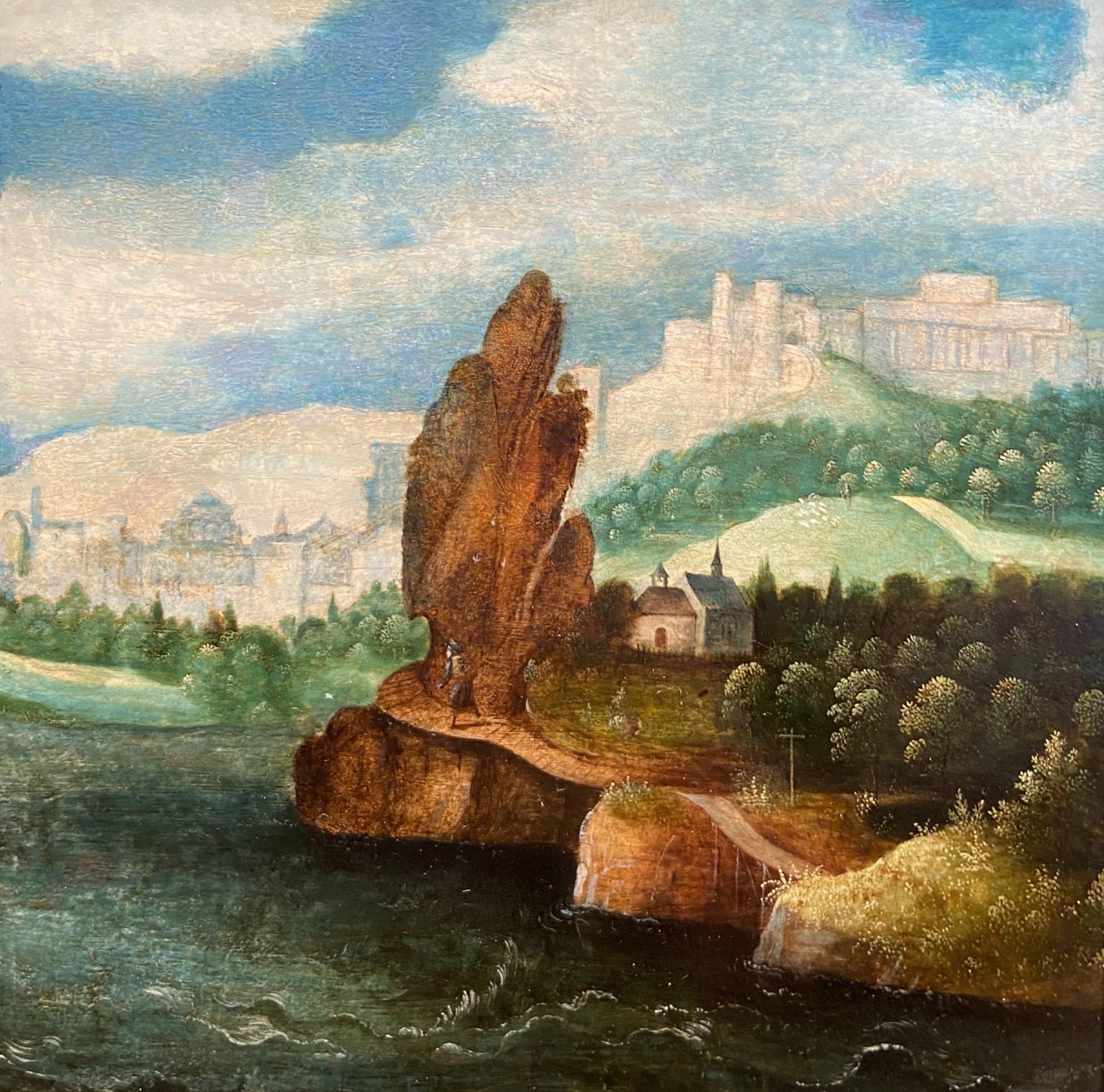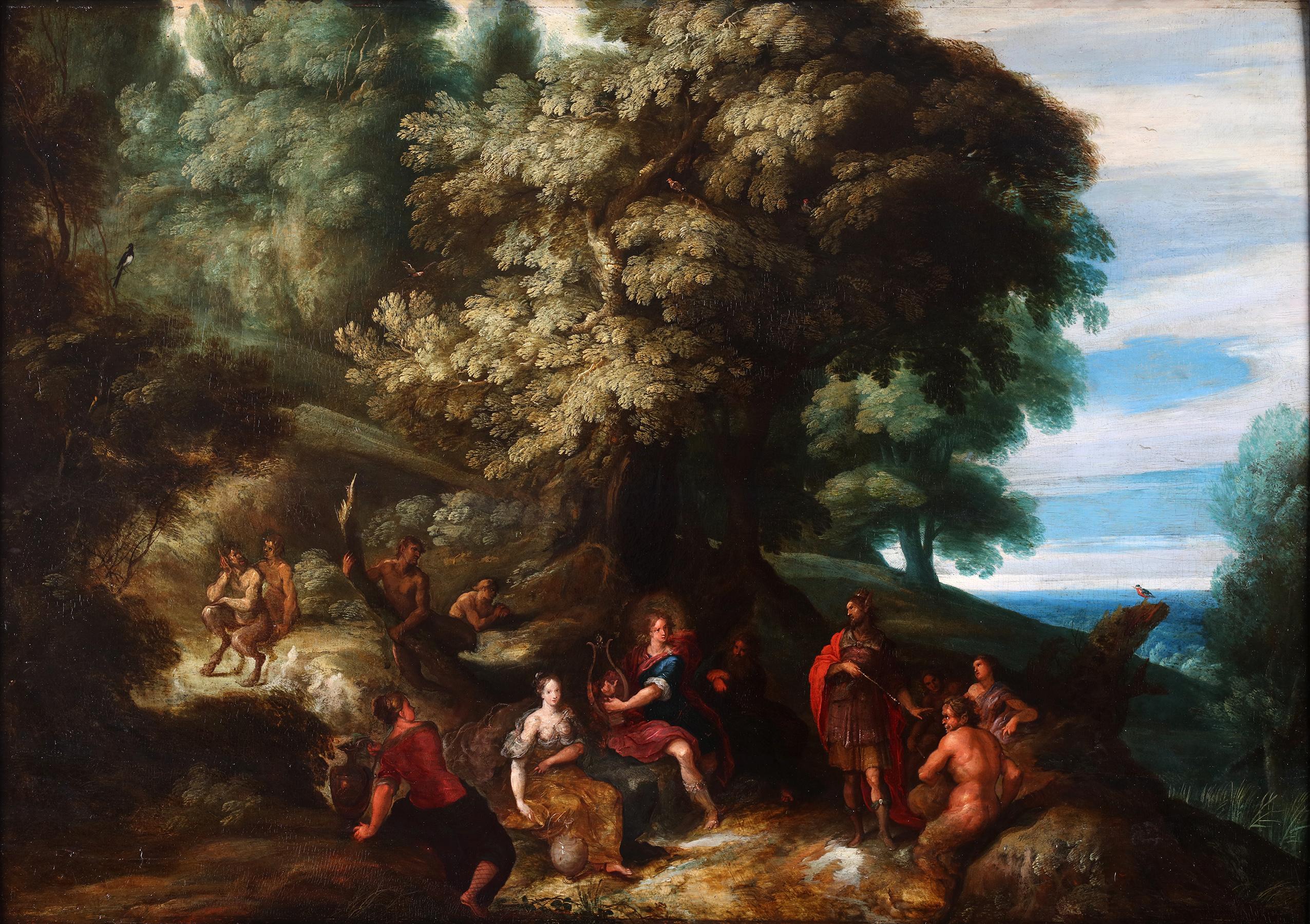Items Similar to Two scenes showing a fish market in front of a town - Mathijs Schoevaerdts
Want more images or videos?
Request additional images or videos from the seller
1 of 10
Matthijs SchoevaerdtsTwo scenes showing a fish market in front of a town - Mathijs Schoevaerdts
About the Item
Oil on canvas
Dimensions: 38 x 67 cm
Schoevaerdt's specialty was combination landscapes, in which airy landscapes are often combined with a body of water and imaginative capriccio-like architecture, whereby the figure staffage was often provided by fellow painters such as Pieter Bout (1658-1719). One painting in particular, sold at Sotheby's, Amsterdam on November 7, 2000, lot 83, shows clear parallels to the architecture of the present painting.
We can see a bay on the shore of which fishing boats have landed, whose fishermen are about to sell their wares to residents of a city who have gathered in front of the imaginative architecture.
- Creator:Matthijs Schoevaerdts (1663 - 1703, Flemish)
- Dimensions:Height: 14.97 in (38 cm)Width: 26.38 in (67 cm)
- Medium:
- Movement & Style:
- Period:
- Condition:
- Gallery Location:Gent, BE
- Reference Number:1stDibs: LU2239213504522
About the Seller
No Reviews Yet
Vetted Seller
These experienced sellers undergo a comprehensive evaluation by our team of in-house experts.
Established in 1999
1stDibs seller since 2022
- ShippingRetrieving quote...Ships From: Gent, Belgium
- Return PolicyThis item cannot be returned.
More From This SellerView All
- The Judgement of Midas - Frans Francken II and Gijsbrecht LeytensLocated in Gent, BEOil on panel Perfect condition Housed in a 17th century style frame by Gehring Amsterdam framers We are grateful to Ursula Härting for confirming the attribution of the present painting to Francken (figures) and Leytens (landscape). A written certificate, dated 1 February 2022, is available. She dates the present Midas to the second half of the 1620s. The painting The Judgement of Midas, known to me in the original, was painted by Frans Francken the Younger...Category
17th Century Flemish School Landscape Paintings
MaterialsOil, Wood Panel
- Animated harbor scene near a fortified palace - Matthijs SchoevaerdtsLocated in Gent, BEOil on panel Mathys Schoevaerdts is known for his landscape art and genre scenes. His landscapes are full of anecdotes and delicately painted scenes of peasants travelling, sailing ...Category
17th Century Flemish School Landscape Paintings
MaterialsOil, Wood Panel
- View of animated Italianate harbour - Johannes Sturckenburgh (1603-1663)Located in Gent, BEOil on canvas Signed lower right: “Johannes van Sturckenburgh,” Johannes Sturckenburgh’s “View of an Animated Italiante harbour,” is a piece that transports viewers to a picturesqu...Category
17th Century Dutch School Landscape Paintings
MaterialsCanvas, Oil
- A view of a street in San Remo - Jacques Carabain (1834 - 1933)Located in Gent, BEOil on canvas Signed and dated lower right: "J. Carabin, 1886" Also with a label on the back. In Jacques Carabain's painting, the Concattedrale di San Siro emerges as a timeless beacon amidst the historic tapestry of San Remo's Via Palma van La Pigna. The canvas unveils a captivating vista, capturing the architectural grandeur of the cathedral framed...Category
Mid-19th Century Romantic Landscape Paintings
MaterialsCanvas, Oil
- The Leye in March - Modest Huys (1874 - 1932)Located in Gent, BEOil on canvas Signed lower right: "M. Huys" A dedication on the backside: "To my friend Georges, with friendship. Zonne-Huys-Zulte, 5 June 1927." Modest Huys was a Flemish impressi...Category
Early 20th Century Impressionist Landscape Paintings
MaterialsCanvas, Oil
- Geese going into the Leie - Gustaaf De Smet (Gent 1877 -1943)Located in Gent, BEOil on canvas Signed lower right: “Gustave De Smet” “Geese going into the Leie,” by Gustave De Smet captures a serene moment in the Belgian countryside. The painting invites viewers to witness a simple yet captivating scene: three geese making their way towards the Leie River. De Smet’s Impressionist style is characterized by his ability to capture the essence of the moment, emphasizing the interplay of light and color to create a calm atmosphere. The geese appear to move with purpose, marching gracefully toward the water. The Leie itself is a tranquil presence, next to the water there is a solitary tree and a shed. The tree leaves and the shed...Category
Late 19th Century Impressionist Landscape Paintings
MaterialsCanvas, Oil
You May Also Like
- 18th Century Winter Landscape Flemish School Snow Nature Oil on Canvas WhiteLocated in Sanremo, ITPainting, oil on canvas, measuring 55 x 35 cm without frame and 66 x 46 cm with a non-coeval frame, initialled at lower left in an unreadable manner, of the Flemish school. The main...Category
Late 18th Century Flemish School Landscape Paintings
MaterialsCanvas, Oil
- Late XVIcentury. Flemish Artist active in Rome. Quo Vadis with Ancient Rome viewLocated in Firenze, ITThe painting represents the meeting of Jesus Christ with Saint Peter. Late 16th - early 17th century. Technique: oil on canvas. Antique wooden frame...Category
16th Century Flemish School Figurative Paintings
MaterialsCanvas, Oil
- 18th Century Landscape Flemish School Nature Wayfarers Oil on Canvas GreenLocated in Sanremo, ITPainting oil on panel measuring 48 x 32 cm without frame and 58 x 43 cm with frame depicting a landscape with figures from the Flemish school of the 18th century. A lively painting ...Category
Mid-18th Century Flemish School Landscape Paintings
MaterialsCanvas, Oil
- 18th Century Landscape Flemish School People and Cows Oil on Canvas GreenLocated in Sanremo, ITFlemish painting measuring 44 x 30 cm without frame and 53 x 39 cm with frame depicting a landscape with figures, in soft tones and with a strong sense of perspective; elegant, fluid...Category
18th Century Flemish School Landscape Paintings
MaterialsCanvas, Oil
- Landscape with Rocky VistaLocated in London, GBOil on oak panel Image size: 6 1/4 x 6 1/4 inches (15.75 x 15.75 cm) Period ebonised frame Patinir’s poetic imagination allowed him to express an idealised world, or one steeped in pathos, with profound sentiments, and always with perfect technique. The level of detail in this work is astonishing and the viewer is sure to make new discoveries every time that they gaze upon it, such as the birds diving down from the rocky form or the spindly poles that hold up the bowing bridge. Patinir's landscapes recall the background landscapes in the work of his contemporary Netherlandish painters, such as Gerard David. His magnificent rendering of light and shadows also foreshadow the great Dutch masters of the 17th century; as well does his excellent use of colour—especially his delightful range of blues and greens. Together, these traits make his works both innovative and uncommonly attractive. Here, although the scene is populated, the figures are small and the landscape assumes increasing importance. Joachim Patinir Joachim Patinir, who was born on the banks of the Meuse River, is considered the first Flemish landscape painter. His vast, highly personal landscapes are characterized by large expanses of terrain with high horizons and fantastic outcroppings of pointed rock that combine real and symbolic. He is thought to have begun his career in Bruges, where he discovered the work of Gérard David, but like David, he appears on a list of Antwerp-based masters in 1515. There, he met and befriended Albrecht Dürer, who visited the Netherlands in 1520-1521. Dürer subsequently painted his portrait and even attended his daughter’s wedding. Patinir was also friends with Quintin Massys, who painted some of the figures in his works. Their friendship was so lasting that Massys’ son, Cornelis, apprenticed with Patinir. Cornelis eventually married Patinir’s daughter, Francisca Buyts, and the elder painter became their tutor. In 1521, Patinir remarried, this time to Jeanne Nuyts. His life was quite short, and he produced relatively few paintings, notwithstanding certain mediocre works erroneously attributed to him. His fame is due primarily to his final paintings, whose masterful technique and creativity were praised by his peers. In his travelogue, Dürer called him "a good landscape painter", and Felipe de Guevara, a friend and artistic assessor to both Charles V and Philip II, mentions him in his "Commentaries on Painting" (1540) as one of the three greatest painters, alongside Rogier van der Weyden and Jan van Eyck. His work was also very successful on the art market, especially when we recall that, in 16th-century Antwerp, artists did not work on commission. Instead, they sold finished works to their clients. From the very start, Patinir’s paintings reflect the influence of Hieronymus Bosch, although they lack that master’s satirical edge. He was also influenced by Gérard David, from whom he drew his perfect execution as well as his taste for landscape. His name appears on two early works—"Saint Jerome" (Staatliche Kunsthalle, Karlsruhe) and "The Flight to Egypt" (Koninklijk Museum voor Schone Kunsten, Antwerp)—but his inscriptions on three other panels—"The Baptism of Christ" (Kunsthistorisches Museum, Vienna), "Landscape with...Category
16th Century Flemish School Landscape Paintings
MaterialsOak, Oil
- A river landscape with travellers by a jetty and a man in a rowing boatBy David Teniers the YoungerLocated in Tallinn, EEDavid Teniers the Younger Antwerp 1610 - 1690 Brussels A river landscape with travellers by a jetty and a man in a rowing boat, a church beyond Signed with monogram lower right: DT. ...Category
17th Century Flemish School Landscape Paintings
MaterialsOak, Oil, Panel
Recently Viewed
View AllMore Ways To Browse
City Market
Market Scene
Market Scene Painting
Antique Fish Art
School Of Fish
Shore Scene Painting
School Of Fish Painting
Fish Market
Antique Fish Painting
Fishing Town
17th Century Flemish School
Capriccio Painting
Oil Painting Capriccio
Flemish School Oil On Canvas 17th Century
Architectural Capriccio
19th Century Oil
Popular Artist
Womens Shors





